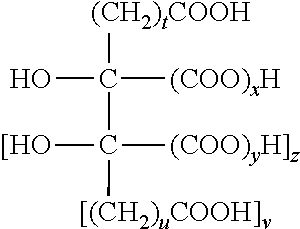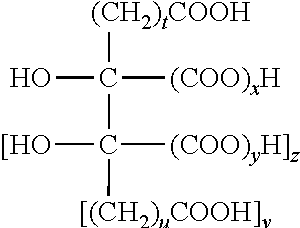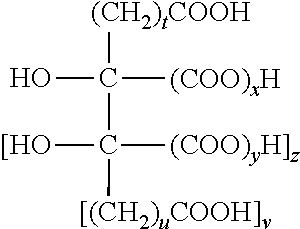Methods and compositions for improving the quality and durability of color in artificially colored hair
a technology of color protection and composition, applied in the field of compositions and methods for improving the quality and durability of color protection in artificially colored hair, can solve the problems of color beginning to fade, become muddy and dull, and achieve the effect of maximizing the mordant properties
- Summary
- Abstract
- Description
- Claims
- Application Information
AI Technical Summary
Benefits of technology
Problems solved by technology
Method used
Image
Examples
example 1
Rinse-Off Post-Color Treatment Method
[0230]Hair swatches (from IHIP, about 1.5 grams) were colored using a commercial hair coloring product (1 g color crème / 1.5 g developer / 1 g hair) for 30 minutes to give the hair an intense auburn color. These colored hair swatches were then treated with one of the following post-color treatments.
Post-Color Treatment with Hydroxy-Polycarboxylic Acid:
[0231]The colored hair swatches were treated with 40 wt. % solution of citric acid (0.5 g solution / 1 g hair). The solution of 40 wt. % citric acid was allowed to remain on the hair at room temperature for 20 minutes, then rinsed with water for 10 seconds.
Post-Color Treatment with Alkaline Earth Metal Salt:
[0232]The colored hair swatches were treated (0.5 g solution / 1 g hair) with 50 wt. % solution of calcium chloride (CaCl2). The solution of 50 wt. % calcium chloride was allowed to remain on the hair at room temperature for 20 minutes, then rinsed with water for 10 seconds.
Post-Color Treatment with Bot...
example 2
Leave-On Post-Color Treatment Method
[0238]Hair swatches (from IHIP, about 1.5 grams) were colored using a commercial hair coloring product (1 g color crème / 1.5 g developer / 1 g hair) for 30 minutes to give the hair an intense auburn color. These colored hair swatches were treated with one of the following post-color treatments. The colored hair swatches were treated with a solution comprising 5 wt. % citric acid and 5 wt. % calcium chloride (CaCl2) or with a solution comprising 10 wt. % citric acid and 10 wt. % calcium chloride (CaCl2) (0.5 g solution / 1 g hair).
[0239]The total change in hair color (ΔE) after shampooing 10 times was assessed based on the L*, a*, b*, values. The higher the ΔE the more the color change (more fading) compared to the initial color.
[0240]
ΔE After ShampooingTreatment10 TimesTypical Color Treatment (Control)9.1(no alkaline earth metal salt)Post-color treatment with both 5 wt. % Hydroxy-4.3Polycarboxylic Acid (citric acid) and 5 wt. %Alkaline Earth Metal Salt...
example 3
In-Color Treatment and Post-Color Treatment Method
[0242]Hair swatches (from IHIP, about 1.5 grams) were subjected to one of the following four treatments.
Typical Color Treatment:
[0243]Hair swatches were colored using a commercial hair coloring product (1 g color creme / 1.5 g developer / 1 g hair) for 30 minutes to give the hair an intense auburn color.
In-Color Treatment with Alkaline Earth Metal Salt:
[0244]Hair swatches were colored with the same commercial hair coloring product above, except that an alkaline earth metal salt (CaCl2) was included with the coloring composition (1 g of 30 wt. % CaCl2 / 1 g color creme / 1.5 g developer / 1 g hair). The hair was treated with the coloring composition for 30 minutes to give the hair an intense auburn color.
Post-Color Treatment with Hydroxy-Polycarboxylic Acid:
[0245]Hair swatches were colored using a commercial hair coloring product (1 g color crème / 1.5 g developer / 1 g hair) for 30 minutes to give the hair an intense auburn color. After coloring, ...
PUM
| Property | Measurement | Unit |
|---|---|---|
| temperature | aaaaa | aaaaa |
| temperature | aaaaa | aaaaa |
| temperature | aaaaa | aaaaa |
Abstract
Description
Claims
Application Information
 Login to View More
Login to View More - R&D
- Intellectual Property
- Life Sciences
- Materials
- Tech Scout
- Unparalleled Data Quality
- Higher Quality Content
- 60% Fewer Hallucinations
Browse by: Latest US Patents, China's latest patents, Technical Efficacy Thesaurus, Application Domain, Technology Topic, Popular Technical Reports.
© 2025 PatSnap. All rights reserved.Legal|Privacy policy|Modern Slavery Act Transparency Statement|Sitemap|About US| Contact US: help@patsnap.com



